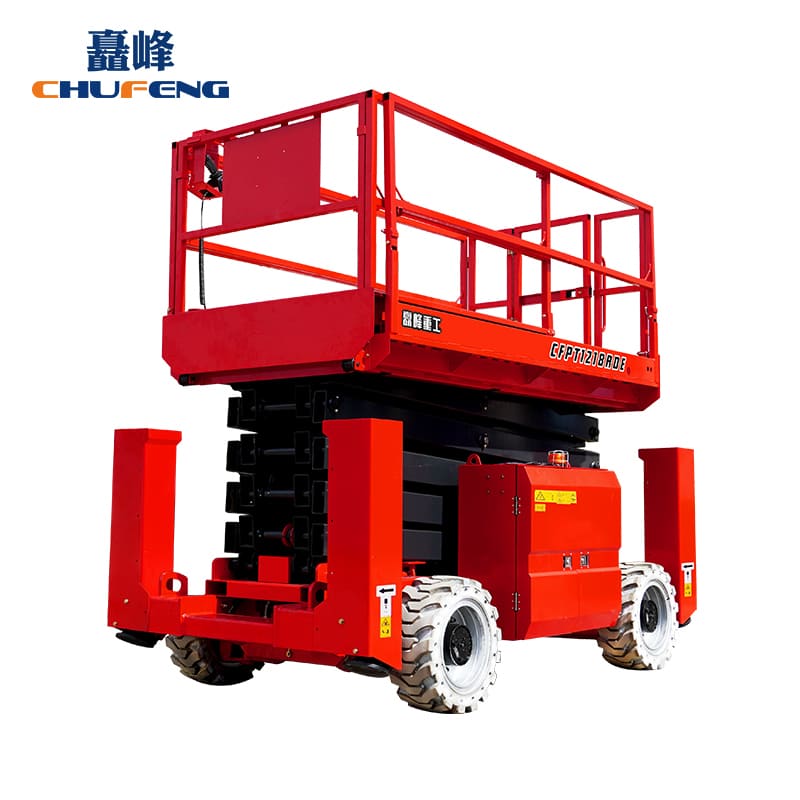Hydraulic scissor lifts work method:
Power source: Hydraulic scissor lifts are powered by a hydraulic system, which usually consists of a pump, reservoir, and hydraulic cylinders.
Lifting Operation: When the operator activates the control panel, the hydraulic pump pressurizes the hydraulic fluid in the system.
Fluid Transfer: The pressurized hydraulic fluid is then directed to the hydraulic cylinders, causing them to extend. This extension pushes the scissor-like crossbar out of the way, raising the platform.
Platform Movement: The platform is smoothly raised to the desired height and can be precisely adjusted using the control panel.
Lowering: The operator activates the control panel again to lower the platform. The hydraulic pump reverses, allowing fluid to flow back into the reservoir. Retraction of the hydraulic cylinders gently lowers the platform.
Safety features: Hydraulic scissor lifts typically include safety features such as emergency stop buttons and safety rails to ensure safe operation.
Pneumatic scissor lift working method:
Power source: Pneumatic scissor lifts are powered by compressed air, usually through an air compressor.
Air Distribution: The operator activates the elevator by controlling the compressed air flow to the elevator system.
Lifting action: When air is supplied to the lift, the air enters the cylinders located within the lift structure.
Platform Raising: Compressed air causes the cylinders to extend, which expands the scissor mechanism, thus raising the platform.
Platform Height Control: The operator can control the height of the lift by adjusting the air pressure using the control panel.
Lowering: To lower the platform, the operator releases the compressed air, which retracts the cylinder and gently reduces the platform.
Safety measures: Pneumatic scissor lifts usually include safety devices such as safety interlocks and emergency shut-off valves.
Diesel scissor lift working method:
Power source: Diesel scissor lifts have a diesel engine as the primary power source.
Engine Start: The operator starts the diesel engine using the ignition system.
Hydraulic system: Most diesel scissor lifts utilize a hydraulic system for lifting.
Lifting Process: When the engine runs, it powers a hydraulic pump pressuring the fluid.
Platform Raising: Pressurized hydraulic fluid is delivered to the hydraulic cylinders, causing them to extend and raise the platform.
Platform Control: The operator can control the height by manipulating the lift controller, which regulates the flow of hydraulic fluid.
Lowering: To lower the platform, the operator lowers the hydraulic pressure so that the cylinders retract and the platform gradually descends.
Safety precautions: Diesel scissor lifts usually have safety features such as outriggers for stabilization and emergency stop buttons.
Electric scissor lift working method:
Power: Electric scissor lifts are powered by electricity, usually from a rechargeable battery pack.
Battery Activation: The operator ensures the battery pack is charged and ready for use.
Motor: Electric scissor lifts have an electric motor connected to a hydraulic or mechanical lift system.
Platform Lift: The electric motor powers the hydraulic or mechanical lift mechanism when the operator activates the lift controls.
Height Adjustment: The operator can precisely adjust the height of the platform by operating the lift control.
Platform Lowering: To lower the platform, the operator reverses the motor so that the lift mechanism retracts and smoothly reduces the platform.
Safety Features: Electric scissor lifts usually have safety features such as overload protection and safety gates to protect the operator.
Post time: Sep-15-2023

